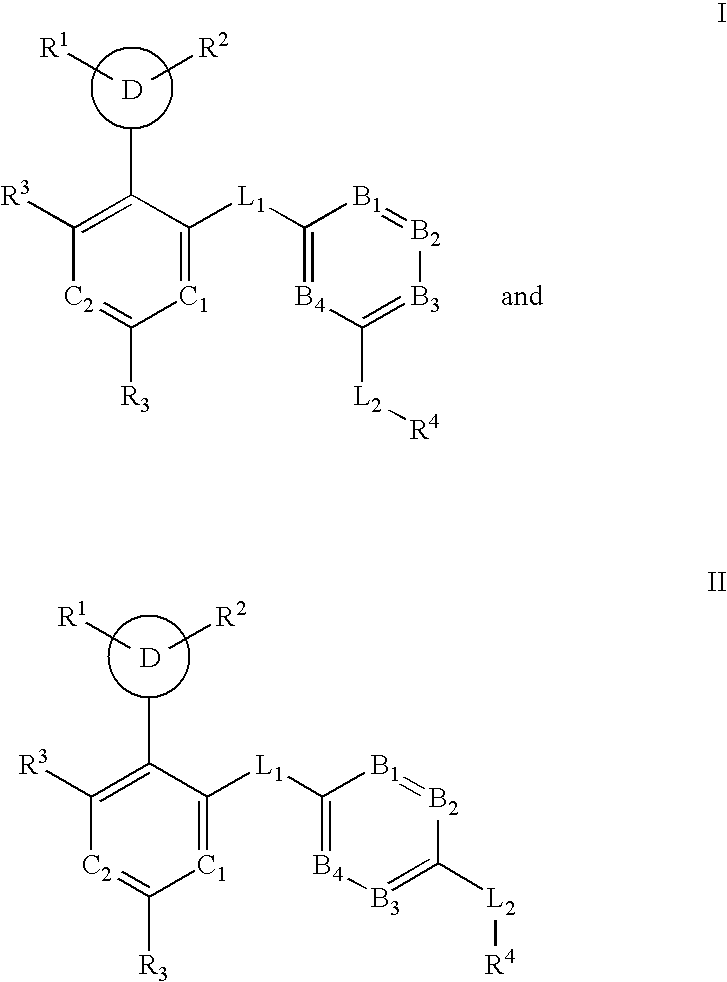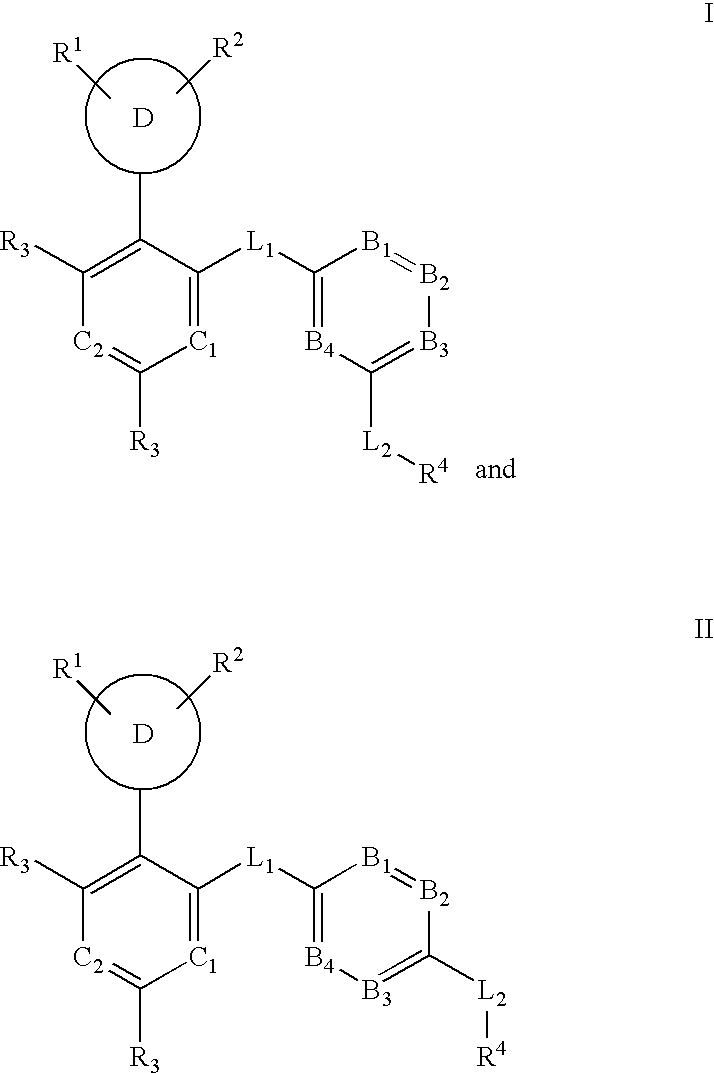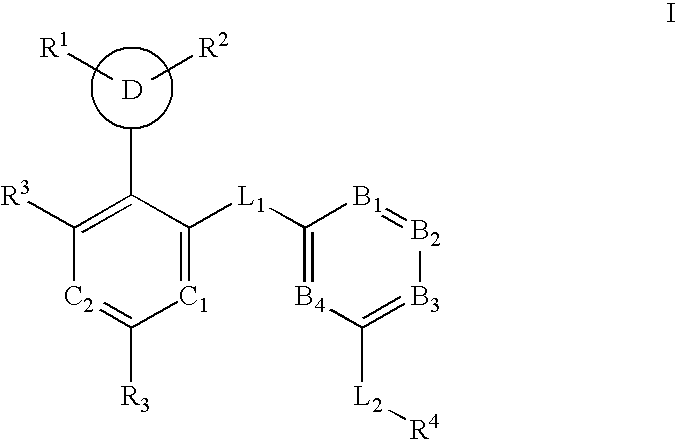Multi-cyclic compounds and methods of use
a multi-cyclic compound and compound technology, applied in the field of multi-cyclic compounds, can solve the problems of endothelial death, loss of vascular structure and matrix contacts, and less favorable anti-angiogenic therapeutic approaches, and achieve the effects of reducing the risk of angiogenic diseas
- Summary
- Abstract
- Description
- Claims
- Application Information
AI Technical Summary
Benefits of technology
Problems solved by technology
Method used
Image
Examples
example 1
[0207]
Synthesis of 3-(3-(1H-pyrazol-4-yl)pyridin-2-yloxy)-N-(3-isopropylphenyl)-4-methylbenzamide
[0208]Step 1: 1-Benzyl-4-iodo-1H-pyrazole (1.35 g, 4.77 mmol), 2-chloropyridin-3-ylboronic acid (1.50 g, 9.53 mmol), sodium bicarbonate (1.20 g, 14.3 mmol) and Pd(PPh3)4 (276 mg, 0.239 mmol) were combined in an argon-purged sealed tube. Dimethoxyethane (8 mL) and water (5 mL) were added and the mixture was heated to 85° C. for 16 hours. The reaction was cooled to rt, diluted with water and extracted into EtOAc. The separated organic layer was dried over anhydrous sodium sulfate, filtered and concentrated. This residue was purified by silica gel chromatography (50-75% EtOAc / hexanes) to yield 3-(1-benzyl-1H-pyrazol-4-yl)-2-chloropyridine as a light yellow oil after concentration. MS m / z=270 [M+1]+. Calc'd for C15H12FN3: 269.74.
[0209]Step 2: 3-Hydroxy-4-methylbenzoic acid (1.07 g, 7.00 mmol), 3-isopropylbenzenamine (0.90 mL, 6.4 mmol), and DMAP (0.27 g, 2.2 mmol) were suspended in 25 mL dry...
example 2
[0212]
Synthesis of N-(2-((3-(dimethylamino)propyl)(methyl)amino)-5-(trifluoromethyl)phenyl)-2-fluoro-5-(3-(oxazol-5-yl)pyridin-2-yloxy)benzamide
[0213]Step 1: To 2-chloronicotinaldehyde (381 mg, 2.69 mmol), 2-fluoro-5-hydroxybenzoic acid (300 mg, 1.92 mmol) and cesium carbonate (1.25 g, 3.84 mmol) was added DMSO (2.5 mL). The mixture was heated to 80° C. in a sealed tube for 3 hours. The cooled reaction was diluted with water and extracted with EtOAc. The aqueous layer was acidified with TFA (pH˜3) and extracted with EtOAc. This layer was dried over anhydrous sodium sulfate, filtered and concentrated. The residue was washed with Et2O dried to yield 2-fluoro-5-(3-formylpyridin-2-yloxy)benzoic acid as an off-white solid. MS m / z=262 [M+1]+. Calc'd for C13H8FNO4: 261.21.
[0214]Step 2: To 2-fluoro-5-(3-formylpyridin-2-yloxy)benzoic acid (230 mg, 0.881 mmol) and TosMIC (172 mg, 0.881 mmol) in DME (8.0 mL) was added DBU (0.29 mL, 1.9 mmol). The mixture was heated to 85° C. for 2.5 hours in a...
example 3
[0217]
Synthesis of 3-(3-(1H-tetrazol-5-yl)pyridin-2-ylamino)-N-(3-isopropylphenyl)-4-methylbenzamide
[0218]Step 1: To 2-chloronicotinonitrile (140 mg, 1.00 mmol) and 3-amino-N-(3-isopropyl-phenyl)-4-methyl-benzamide (80 mg, 0.30 mmol) was added isopropanol (0.8 mL) and TFA (12 drops). The mixture was heated to 130° C. for 16 hours in a sealed tube. The cooled mixture was purified by silica gel chromatography (25% EtOAc / hexanes) to yield 3-(3-cyanopyridin-2-ylamino)-N-(3-isopropylphenyl)-4-methylbenzamide. MS m / z [M+H]+=371; Calc'd for C23H22N4O: 370.46.
[0219]Step 2: To 3-(3-cyanopyridin-2-ylamino)-N-(3-isopropylphenyl)-4-methylbenzamide (11 mg, 0.03 mmol), sodium azide (21 mg, 0.30 mmol) and ammonium chloride (17 mg, 0.30 mmol) was added DMF (0.5 mL). The mixture was heated to 130° C. in the microwave for 10 minutes. The reaction was quenched with saturated sodium bicarbonate and extracted with EtOAc. The organic layer was dried over anhydrous sodium sulfate, filtered and concentrate...
PUM
| Property | Measurement | Unit |
|---|---|---|
| temperatures | aaaaa | aaaaa |
| temperature | aaaaa | aaaaa |
| total volume | aaaaa | aaaaa |
Abstract
Description
Claims
Application Information
 Login to View More
Login to View More - R&D Engineer
- R&D Manager
- IP Professional
- Industry Leading Data Capabilities
- Powerful AI technology
- Patent DNA Extraction
Browse by: Latest US Patents, China's latest patents, Technical Efficacy Thesaurus, Application Domain, Technology Topic, Popular Technical Reports.
© 2024 PatSnap. All rights reserved.Legal|Privacy policy|Modern Slavery Act Transparency Statement|Sitemap|About US| Contact US: help@patsnap.com










